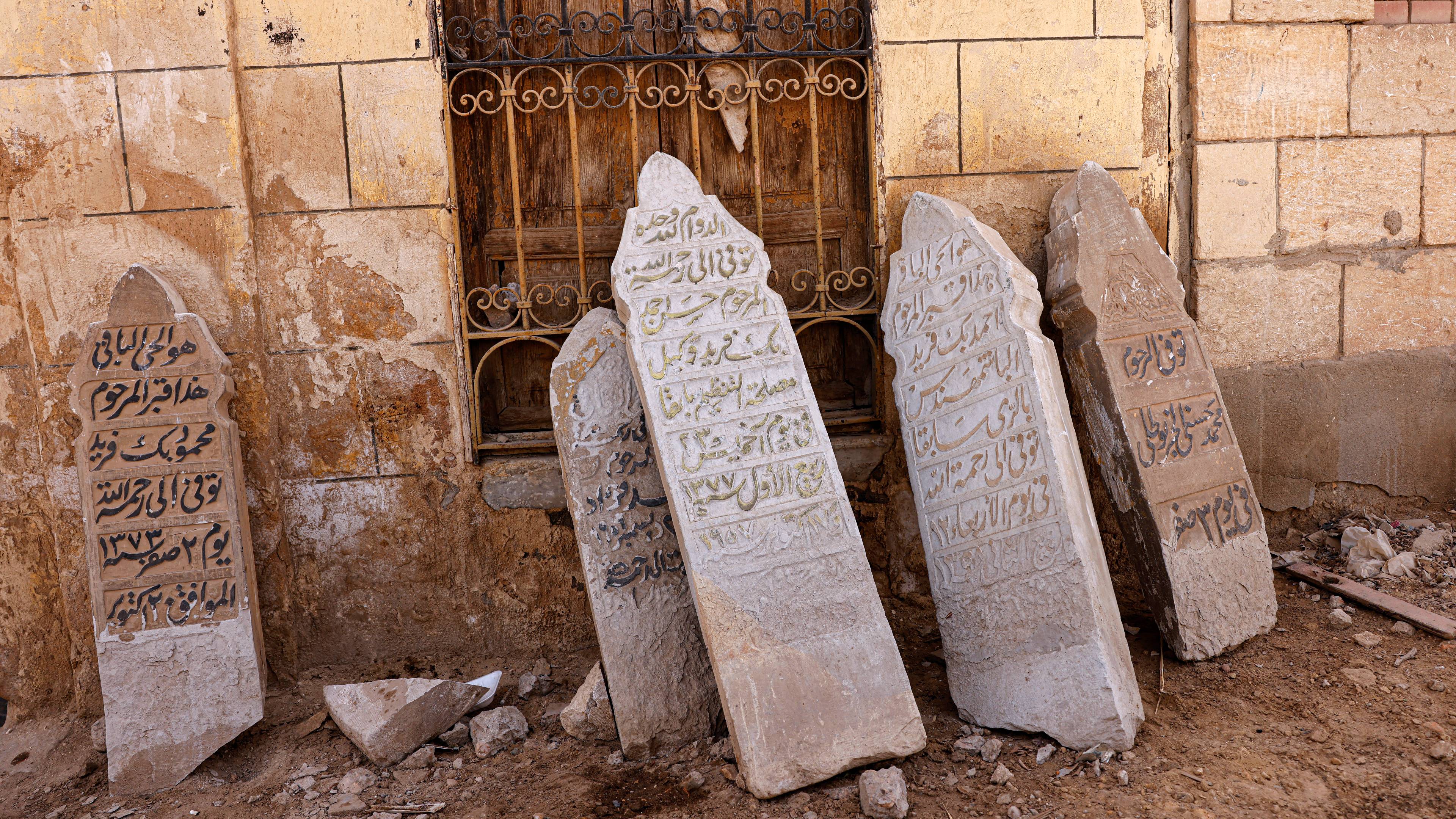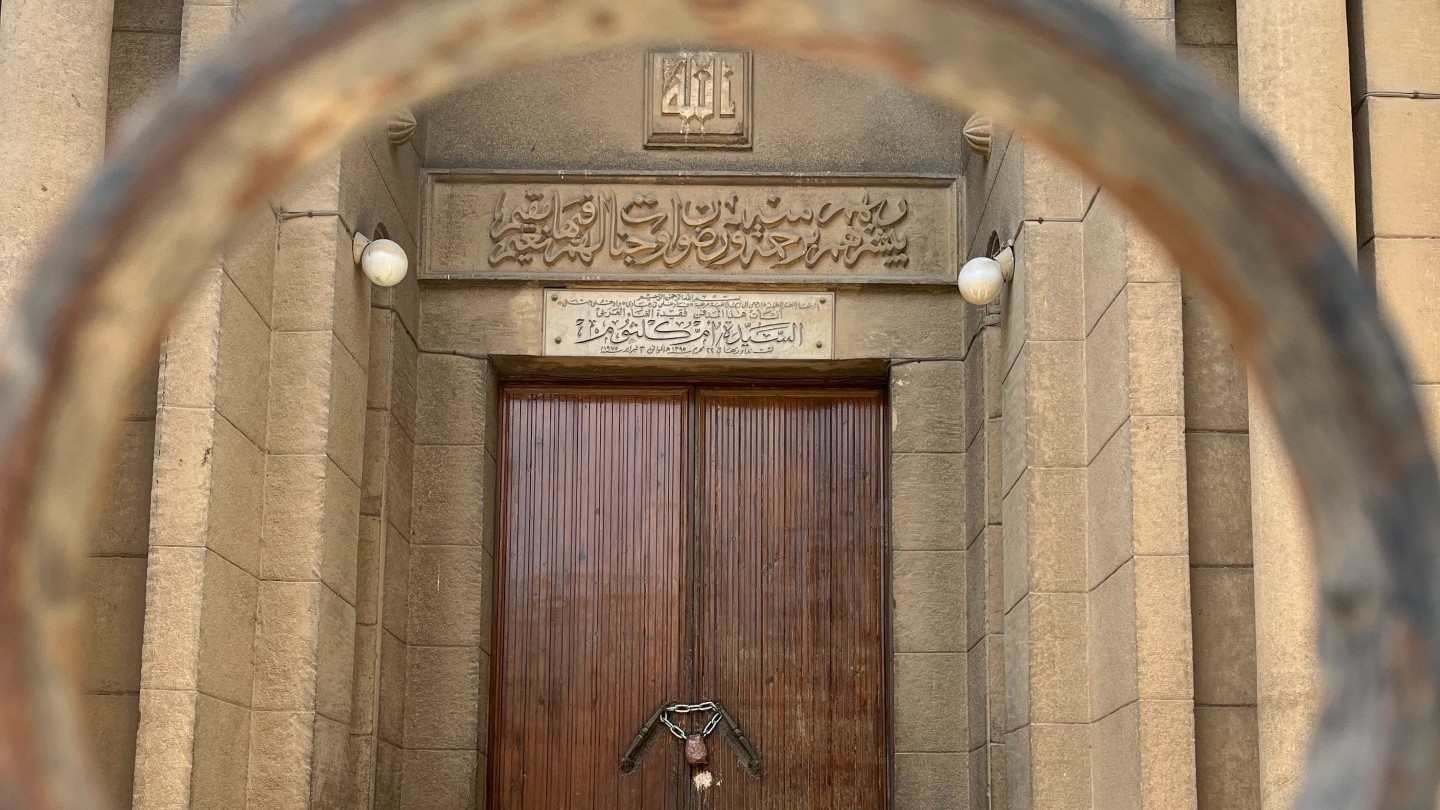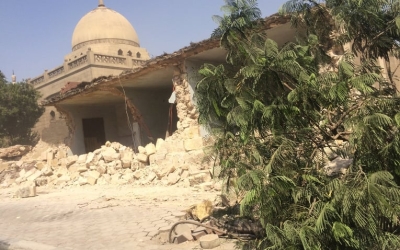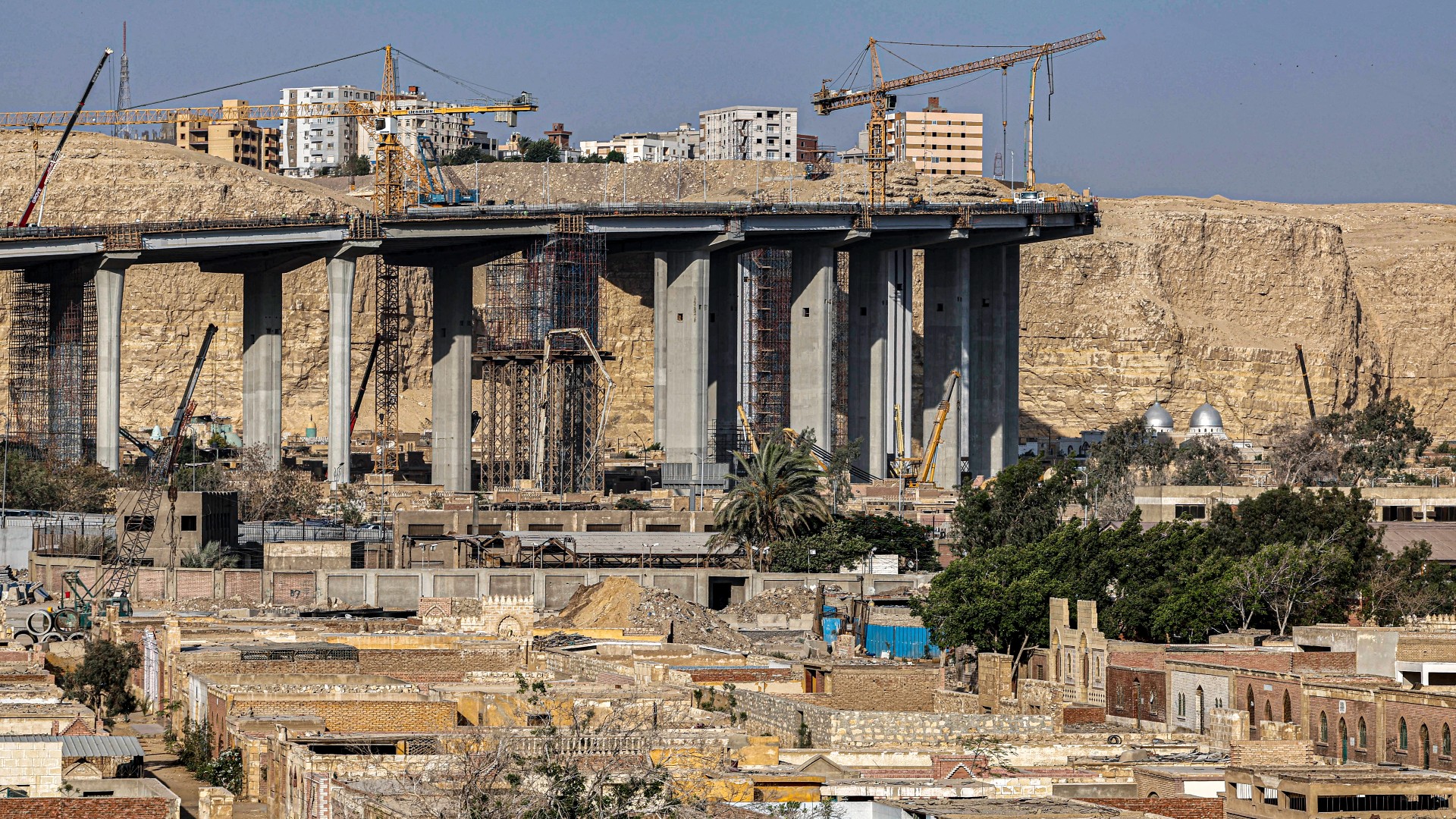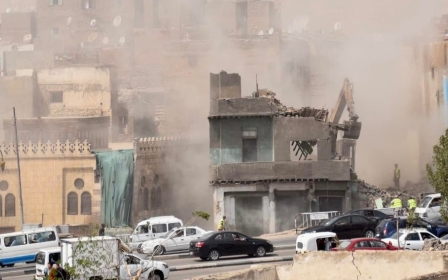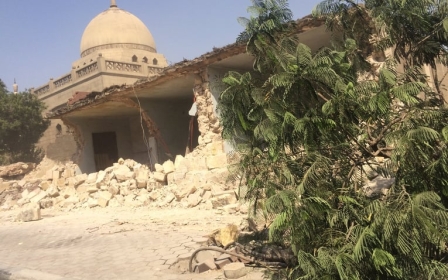In Cairo's City of the Dead, demolitions are halted but 'damage already done'
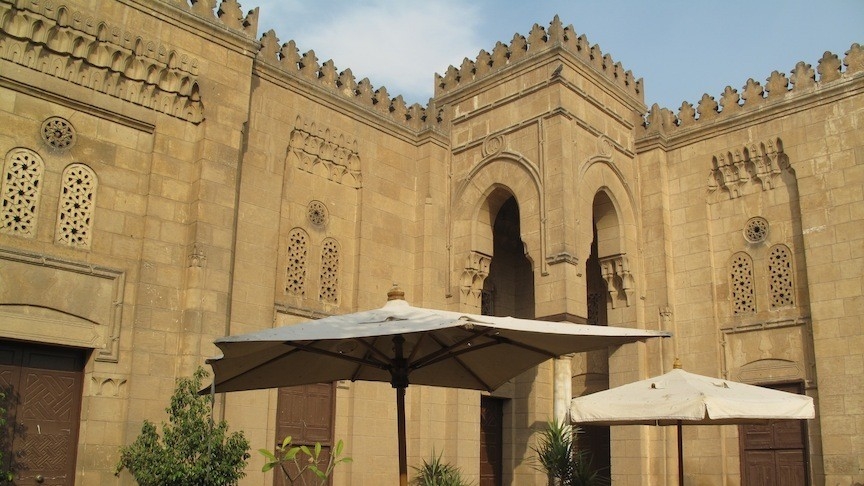
For at least eight generations, Hussein Omar’s family have been buried in Cairo’s City of the Dead, or al-Qarafa, a historic necropolis where mausoleums for Egypt’s prominent politicians, poets, singers, Islamic figures, and families have been laid to rest as early as the 7th century.
When Omar’s mother died 22 years ago, she was interred in the family mausoleum ornamented with stunning Ottoman, European and Islamic elements: Moorish alcoves and windows carved with Islamic geometric patterns.
Commissioned in 1924 by Fathallah Pasha Barakat - Omar’s maternal great-great-grandfather, Egypt’s first post-independence minister of agriculture and one of the leaders of the 1919 anti-colonial revolution, the mausoleum is a historically significant space as much as it is a vestige of Omar’s family history.
“This is a space that I spent a lot of time in. I used to go very frequently when I lived in Cairo as a child,” Omar said, speaking to Middle East Eye.
“Then my mother died when I was 14, and so we started going much more regularly as she was also buried there.”
In mausoleums like the one belonging to Omar's family, a courtyard, an area for guards, and even a seating area for visitors are common.
Despite its architectural splendour, the mausoleum was until recently one of many private family mausoleums threatened with demolition to make way for controversial development projects muscled in by President Abdel Fattah el-Sisi.
The plans included flyover bridges and highways slicing through the Unesco World Heritage site that would connect Cairo, an already overcrowded megacity home to some 20 million people, with a new administrative capital being built to the east.
The Egyptian government has insisted in the past they are removing modern, not Islamic architecture. But demolitions in May caused a social media firestorm after activists claimed old artifacts had been unearthed in the area amid construction work.
Omar, who left Egypt at the age of 17, learned about the demolition plans through X, formerly Twitter, when he stumbled on a photograph of his mother’s grave in a tweet that was tagged #SAVEEGYPTSHERITAGE.
“When the pictures started circulating on Twitter, I was furious,” Omar said.
But, he added that what made it possible for the first spate of demolitions was public indifference or ignorance about the historic cultural value of the mausoleums.
"Why there wasn't much of a public reaction when they happened is because people didn't quite know how aesthetically and historically significant these places were.
"In the popular imagination it was just some cemetery. Because these were by and large private spaces, people didn't know what was being lost.”
Millennia-old resting place
The al-Qarafa necropolis has been in use since the Arab conquest 1,400 years ago.
Sprawled out beneath the Mokattam cliffs rising over the city’s historic centre, stone dwellings complete with seated areas for visitors were built to house the earthly remains of families.
The necropolis has immense religious significance, particularly because of the Imam Shafi’i graveyard constructed around the mausoleum of Imam Shafi’i himself, the Palestinian Muslim legal scholar and founder of the Shafi’i school of thought.
“The Cairo cemetery is the oldest continually used Muslim cemetery in the world,” said Khaled Fahmy, a professor of history at Tufts University.
Over a century ago, the City of the Dead saw a revival of Islamic architecture under a number of Italian architects, including Mario Rossi, a convert to Islam who helped decorate Mecca's Grand Mosque, and also designed Omar’s family mausoleum in 1924.
“The mausoleums built by the Mamluk emirs, and then by members of the 19th century intellectual and political elites, are unrivalled in their elegance and beauty,” Fahmy added, in an interview with MEE.
Since 2020, Cairo’s authorities have relocated thousands of human remains from sections within the City of the Dead. Family members were forced to exhume and relocate remains to new graves in the desert.
In February 2022, the remains of Egypt’s last queen consort, Farida, the wife of King Farouk, were moved from Imam Shafi'i Cemetery to a nearby mosque, following a notice from the government that her family’s tomb would be demolished to make way for a new flyover.
Modernising Cairo
The demolition plans were initially part of late President Hosni Mubarak’s “Cairo 2050” vision, which the Egyptian government unveiled in 2008 in a bid to transform and modernise Cairo by establishing millions of new homes, tens of thousands of acres of green space, and mega-project buildings and highways.
In the summer of 2013, two years after the overthrow of Mubarak, Sisi took the reins, pouring tens of billions of dollars into the country’s glistening new administrative capital where government ministries were also being relocated to, even as the country staggered under the strain of soaring inflation and the devaluation of the Egyptian pound.
The whoosh of cars can be heard from an arterial road within walking distance of the padlocked mausoleum of Umm Kulthum, the inimitable Egyptian songstress, one of many “islands” of historically significant mausoleums clustered around a sea of newly erected flyovers connecting new and old Cairo, that now hurtle over the City of the Dead.
"This is one of a few, if not the only, countries that voluntarily shaves itself of trees and public parks and demolishes its own history in peacetime," said Ahmed Aboudouh, associate fellow at Chatham House and non-resident fellow with the Atlantic Council.
"This government suffers from a concrete fever. But in trying to rebuild Egypt, it turned itself into a wrecking ball for history."
The demolitions in the City of the Dead were symptomatic not just of the monstrous expansion of the nascent administrative capital, but of broader efforts by the Sisi regime to squash mass uprisings after the 2011 revolution, according to Aaron Jakes, an assistant professor of Modern Middle Eastern History at the University of Chicago.
“Big infrastructure projects have been a centrepiece for the Sisi regime,” Jakes said.
'This government suffers from a concrete fever. But in trying to rebuild Egypt, it turned itself into a wrecking ball for history'
- Ahmed Aboudouh, associate fellow at Chatham House
“There has also been a quite concerted effort [from the Egyptian government] to shut down spaces and practices that are understood by the regime to be politically subversive, often under the guise of urban renewal, modernisation, and beautification,” Jakes added.
Relocating government ministry buildings away from the city's large central squares such as Tahrir would insulate the regime from the forms of urban mass politics that exploded during the 2011 revolution, he said.
It is not just the dead who are being evicted from the City of the Dead.
The necropolis - home to large numbers of destitute Egyptians who have lived there for generations - is seething with Egypt’s deep class divide and enduring housing crisis, as many now face being displaced.
"The number of people who took cemeteries as their residence reached 1.5 million in 2008, and this number continued to increase until it reached about 2 million in 2017," said Ibrahim Ezzeldin, a planning engineer and urban researcher at the Egyptian Commission for Rights and Freedoms, who referred to data from the third social development report issued by the United Nations ESCWA in 2019.
Displacement in the aftermath 1967 Arab-Israeli war, combined with the government’s reluctance at this time to construct low-cost housing, even as it pushed for the expansion of the private sector in real estate investment encouraged the formation of "residential islands" in areas like the City of the Dead, Ezzeldin added.
"The Egyptian government does not take into account the opinion of any heritage specialists to develop a mechanism for dealing with these areas, but it has not found a solution other than removal," he said.
In between mausoleums that encrust the graveyard, vibrant trees and bushes sprout out of walled gardens in a city where green spaces are diminishing each year to make way for development projects.
“This is really the last such green space,” Omar said. “Having a few plots of green amid a network of highways is a disaster."
Inside Egypt, the renewed demolitions have sent ripples across the country, sparking criticism from architects, academics, activists, heritage experts, and politicians.
Posting a handwritten resignation on Facebook last Thursday, Ayman Waras, a government official who headed the Committee for the Survey of Buildings and Facilities of Distinguished Architectural Style, resigned in protest at the destruction of Cairo's historic mausoleums.
“The ongoing demolition of the heritage cemeteries is not only a loss of the historical cemetery buildings, but a loss of a historical urban fabric of unique value in the world and an important part of the world heritage,” he wrote.
The next day, Wanas retracted his resignation, stating his resignation had been hijacked to criticise the government, and that he had been assured that the “development plan will be corrected”.
Meanwhile, Diaa Eldin Dawood, a member of Egypt’s House of Representatives, criticised the government, describing the demolitions on Facebook as an “assault on historic Cairo”.
Four members of a committee of heritage experts put together in June to “assess the situation” regarding the transfer of mausoleums, also resigned on Monday in protest.
For the time being, Omar can breathe a tentative sigh of relief that his mother’s mausoleum, and indeed his father’s family plot, will escape the general’s bulldozers for now.
Mada Masr, an independent Egyptian news publication, reported that the demolitions stopped on Sunday although there was a ban on photography in the area amid intense security presence.
Omar confirmed that his father's family mausoleum had been forcibly padlocked, and that the family needed police permission to access their own private properties.
“The government wants to sever the connection that people have to their histories, particularly as these histories are associated with more democratic, freer moments of Egyptian history,” Omar said.
'The government wants to sever the connection that people have to their histories, particularly those associated with more democratic moments of Egyptian history'
- Hussein Omar
Yet the result is an unexpected backlash from across different sectors of Egyptian society. “It's uniting people who would have never seen themselves as politically active or engaged. I've seen that from family members.”
Now living in New York, and with the Sisi administration coming down on family members of individuals who have criticised the president, watching the demolitions from afar effectively in exile has been painful for Omar.
“I’m trying as much as I can to raise awareness,” he said. “I'm safe where I live, my immigration status is secure. But on the other hand, it feels like in doing this, I'm increasing the risk even further of not being able to come back to Egypt.”
In a statement shared with MEE, the Unesco World Heritage Committee expressed concern over the recent demolitions of mausolea, adding that its experts were “closely monitoring the situation”.
News of the most recent demolitions come as Egypt’s former minister of tourism and antiquities, Dr Khaled al-Anany, has been announced as a candidate for the next director general of Unesco.
The state of conservation for the City of the Dead will be re-examined by the World Heritage Committee at its upcoming session in Riyadh from 10 September.
“The damage has already been done,” Omar said. “It's not too late, but it's getting very, very close.”
Middle East Eye propose une couverture et une analyse indépendantes et incomparables du Moyen-Orient, de l’Afrique du Nord et d’autres régions du monde. Pour en savoir plus sur la reprise de ce contenu et les frais qui s’appliquent, veuillez remplir ce formulaire [en anglais]. Pour en savoir plus sur MEE, cliquez ici [en anglais].


